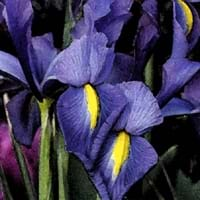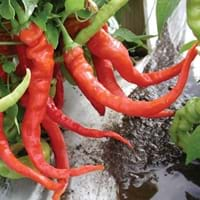Life Span
Perennial
Annual
Type
Herbaceous Perennial
Vegetable
Origin
Hybrid origin
Mexico, Central America, South America
Types
Not Available
Not Available
Habitat
meadows, Riverbanks, Rocky Mountains
Warm soil, Well Drained
USDA Hardiness Zone
5-9
Not Available
Sunset Zone
2b, 3a, 3b, 4, 5, 6, 7, 8, 9, 10, 11, 12, 13, 14, 15, 16, 17, 18, 19, 20, 21, 22, 23, 24
A1, A2, A3, H1, H2, 1a, 1b, 2a, 2b, 3a, 3b, 4, 5, 6, 7, 8, 9, 10, 11, 12, 13, 14, 15, 16, 17, 18, 19, 20, 21, 22, 23, 24
Habit
Clump-Forming
Upright/Erect
Flower Color
White, Yellow, Blue, Purple, Orange, Pink, Rose, Coral, Peach, Burgundy, Lavender, Plum, Orange Red, Dark Salmon, Bronze, Chocolate, Black
White, Green
Flower Color Modifier
Bicolor
Bicolor
Fruit Color
Not Available
Red, Yellow green
Leaf Color in Spring
Green, Light Green, Gray Green
Green
Leaf Color in Summer
Yellow green
Green
Leaf Color in Fall
Not Available
Green, Black
Leaf Color in Winter
Light Green
Green
Leaf Shape
Sword-like
Elliptic
Plant Season
Spring
Spring, Summer, Fall
Sunlight
Full Sun, Partial Sun
Full Sun
Growth Rate
Medium
Medium
Type of Soil
Clay, Loam, Sand
Loam
The pH of Soil
Acidic, Neutral, Alkaline
Neutral
Soil Drainage
Well drained
Well drained
Bloom Time
Early Spring, Spring, Late Spring
Spring, Summer, Indeterminate
Tolerances
Drought
Drought
Where to Plant?
Ground
Container, Ground, Pot
How to Plant?
Root Plants
Seedlings, Transplanting
Plant Maintenance
Medium
Medium
Watering Requirements
Average Water Needs
Do Not over Water
In Summer
Lots of watering
Lots of watering
In Spring
Moderate
Moderate
In Winter
Average Water
Average Water
Soil pH
Acidic, Neutral, Alkaline
Neutral
Soil Type
Clay, Loam, Sand
Loam
Soil Drainage Capacity
Well drained
Well drained
Sun Exposure
Full Sun, Partial Sun
Full Sun
Pruning
Remove damaged leaves, Remove dead branches, Remove dead leaves
Remove damaged leaves, Remove dead branches, Remove dead leaves
Fertilizers
All-Purpose Liquid Fertilizer
All-Purpose Liquid Fertilizer
Pests and Diseases
Bacteria, fungus, Viruses
Cutworms, fungus
Plant Tolerance
Drought
Drought
Flowers
Yes
Insignificant
Flower Petal Number
Single
Single
Foliage Texture
Fine
Medium
Foliage Sheen
Matte
Glossy
Attracts
Butterflies, Hummingbirds
Not Available
Allergy
Not Available
Hives, Rash
Aesthetic Uses
Beautification, Showy Purposes
Showy Purposes
Beauty Benefits
Not Available
Not Available
Environmental Uses
Air purification
Air purification
Medicinal Uses
Not Available
anti-inflammatory, Antioxidants, Arthritis, Cancer, Gastritis, Nutrients, Weight loss
Part of Plant Used
Flowers, Root
Fruits
Other Uses
Basketary, Used for fragrance
Used As Food
Used As Indoor Plant
No
No
Used As Outdoor Plant
Yes
Yes
Garden Design
Cutflower, Foundation, Mixed Border, Rock Garden, Wall
Bedding Plant, Container, Edible, Herb / Vegetable, Mixed Border, Tropical
Botanical Name
IRIS 'Apollo'
CAPSICUM annuum 'Italian Pepperoncini'
Common Name
Carmen Iris, Dutch Iris
Pepperoncini Pepper
In Hindi
Dutch Iris
Pepperoncini Pepper
In German
Dutch Iris
Pepperoncini Pepper
In French
Dutch Iris
Pepperoncini Pepper
In Spanish
Dutch Iris
Pepperoncini Pepper
In Greek
Dutch Iris
Pepperoncini Pepper
In Portuguese
Dutch Iris
Pepperoncini Pepper
In Polish
Dutch Iris
Pepperoncini Pepper
In Latin
Dutch Iris
Pepperoncini Pepper
Phylum
Magnoliophyta
Anthophyta
Class
Magnoliopsida
Not Available
Order
Asparagales
Solanales
Family
Iridaceae
Solanaceae
Clade
Angiosperms, Monocots
Asterids, Eudicots
Subfamily
Iridoideae
Solanoideae
Number of Species
Not Available
Season and Care of Dutch Iris and Pepperoncini Pepper
Season and care of Dutch Iris and Pepperoncini Pepper is important to know. While considering everything about Dutch Iris and Pepperoncini Pepper Care, growing season is an essential factor. Dutch Iris season is Spring and Pepperoncini Pepper season is Spring. The type of soil for Dutch Iris is Clay, Loam, Sand and for Pepperoncini Pepper is Loam while the PH of soil for Dutch Iris is Acidic, Neutral, Alkaline and for Pepperoncini Pepper is Neutral.
Dutch Iris and Pepperoncini Pepper Physical Information
Dutch Iris and Pepperoncini Pepper physical information is very important for comparison. Dutch Iris height is 25.40 cm and width 12.70 cm whereas Pepperoncini Pepper height is 45.70 cm and width 30.50 cm. The color specification of Dutch Iris and Pepperoncini Pepper are as follows:
Dutch Iris flower color: White, Yellow, Blue, Purple, Orange, Pink, Rose, Coral, Peach, Burgundy, Lavender, Plum, Orange Red, Dark Salmon, Bronze, Chocolate and Black
Dutch Iris leaf color: Green, Light Green and Gray Green
Pepperoncini Pepper flower color: White and Green
- Pepperoncini Pepper leaf color: Green
Care of Dutch Iris and Pepperoncini Pepper
Care of Dutch Iris and Pepperoncini Pepper include pruning, fertilizers, watering etc. Dutch Iris pruning is done Remove damaged leaves, Remove dead branches and Remove dead leaves and Pepperoncini Pepper pruning is done Remove damaged leaves, Remove dead branches and Remove dead leaves. In summer Dutch Iris needs Lots of watering and in winter, it needs Average Water. Whereas, in summer Pepperoncini Pepper needs Lots of watering and in winter, it needs Average Water.





